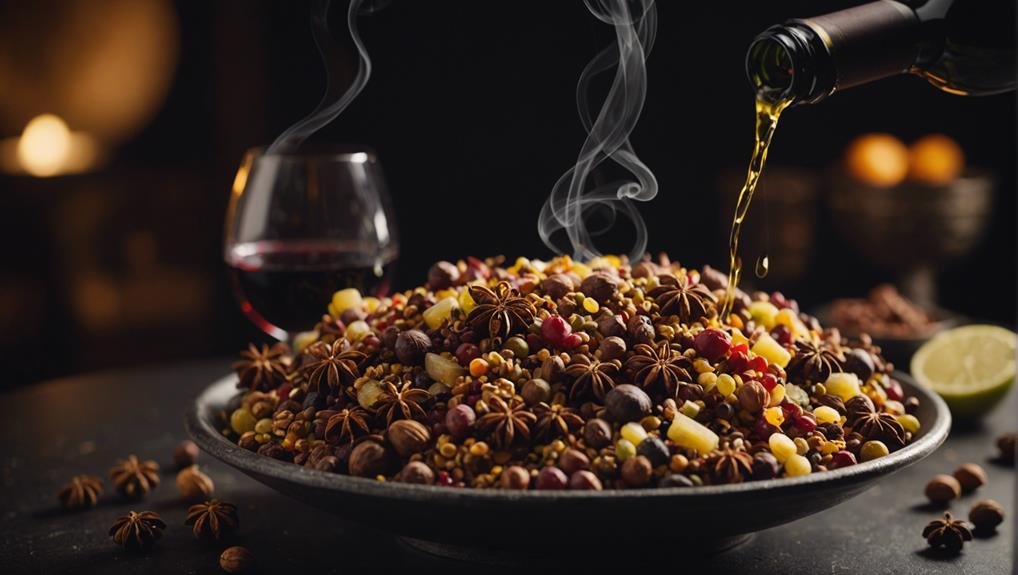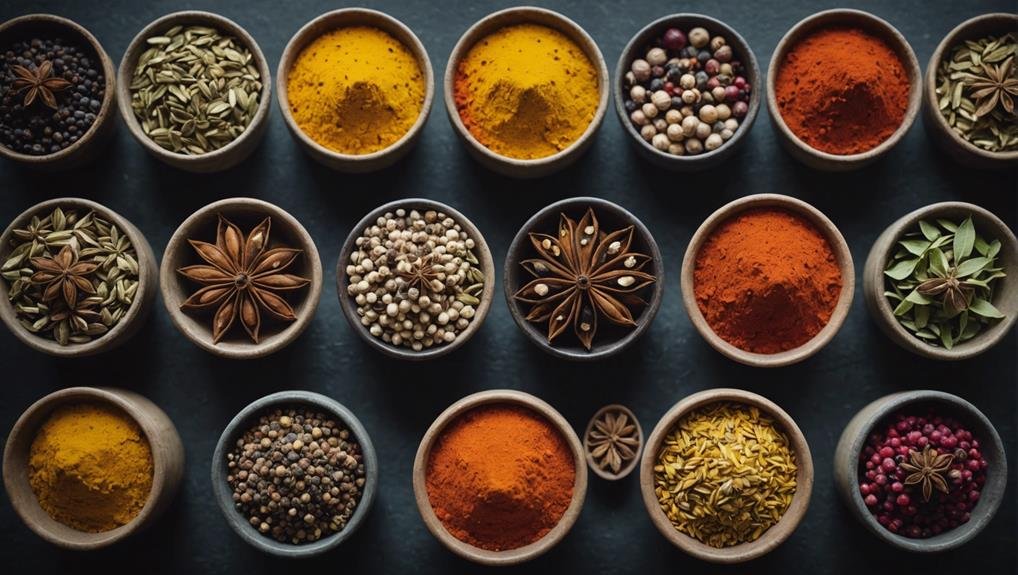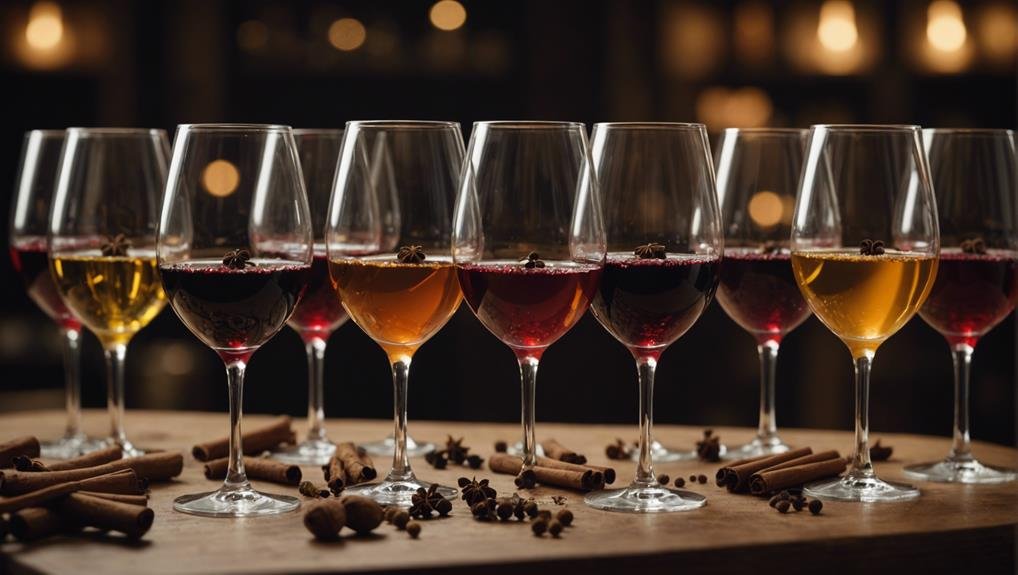The fascinating relationship between wine and spices opens up a world of sensory delights for your taste buds. Understanding the chemistry behind these ingredients reveals a symphony of flavors for those who enjoy the art of food.
By exploring how these elements interact, a tapestry of taste is woven, creating a culinary experience that invites you to savor every bite and sip.
Let's delve into the harmonious blend of wine and spices, where each mouthful promises a delightful flavor symposium that goes beyond just tasting good.
Aroma Compounds in Wine and Spices

Studying the aroma compounds found in wine and spices is essential for understanding how flavors can be harmoniously paired in cooking. These compounds play a crucial role in identifying shared elements that enhance the overall taste experience.
For example, both Syrah wine and black pepper contain rotundone, creating a delightful flavor combination when paired together. By uncovering these shared compounds, one can create more cohesive and enjoyable flavor pairings.
Understanding the chemistry behind aroma compounds in wine and spices is key to unlocking the full potential of flavor interactions. It enables strategic pairing choices based on complementary elements, resulting in a heightened sensory experience.
Exploring the world of aroma compounds enriches our appreciation of flavors and helps in creating memorable culinary moments.
Congruent Pairing Benefits
Studying the common aroma compounds found in both wine and spices not only helps in creating flavorful combinations but also serves as a basis for understanding the advantages of matching similar flavors.
Congruent pairings, which align like flavors, can intensify the overall taste experience and elevate the dining pleasure by enhancing flavors through their similarities.
Spice Categorization for Wine Pairing

Understanding the taste profiles of spices is essential for successful wine pairings. By categorizing spices based on their flavor characteristics like earthy, spicy, floral, or citrusy, it becomes easier to find wines that complement them well.
This classification helps in choosing wines that enhance the flavors of dishes by matching them with the right spices. Whether grouping by cultural cuisines or base spice blends, having a structured approach to selecting wine pairings simplifies the process.
Considering the taste profiles of spices enables individuals to make informed decisions when choosing wines, leading to delightful flavor combinations that elevate the dining experience.
Theory of Congruent Pairing
The key idea behind successful wine and spice pairings is based on several concepts:
- Congruent Pairing Theory: Matching wine with spices and herbs based on shared compounds for a flavorful experience.
- Enhanced Flavor Experience: The concept of intensifying and elevating taste by pairing similar flavors.
- Harmonious Combinations: Achieving successful matches by understanding the shared compounds between wine and spices.
Enhancing Wine Education Through Pairings

Exploring herb and spice pairings can enhance wine education by expanding one's palate and understanding of flavor interactions. When combining specific herbs and spices with wines, individuals not only improve their tasting experience but also gain insights into flavor profiles.
Understanding the shared compounds between spices and wine can help in creating harmonious pairings. Embracing herb and spice combinations offers a creative way to elevate wine tasting experiences, allowing enthusiasts to appreciate the intricate flavors that can be achieved through thoughtful pairings.
Frequently Asked Questions
How Do Different Types of Wine Affect the Perception of Spice Flavors?
Different types of wine can influence the way spice flavors are perceived. For instance, bold red wines can enhance the intensity of spices, while crisp white wines may provide a contrasting and balancing effect. This interaction between wine and spices can significantly enhance the overall dining experience by creating a harmonious blend of flavors that elevate the taste profiles.
Can Using Fresh Spices Versus Dried Spices Alter Wine Pairings?
When it comes to wine pairings, the choice between using fresh spices or dried ones can significantly impact the overall taste experience. Fresh spices tend to have more vibrant and potent flavors, which can influence how the wine interacts with the dish. The decision between fresh and dried spices plays a crucial role in creating harmony and enhancing the flavors in the pairing.
Are There Specific Wine and Spice Pairings That Can Enhance Umami Flavors?
Pairing wines with savory spices like soy sauce, mushrooms, or miso can enhance the umami flavors in your dishes. For a delightful taste experience, consider matching umami-rich meals with wines such as Pinot Noir or aged red wines.
Does the Intensity of Spice in a Dish Impact the Choice of Wine Pairing?
When pairing wine with spicy dishes, it's crucial to consider the impact of spice on the overall flavor profile. For spicy foods, opt for bold and robust wines to complement and balance the intense flavors. On the other hand, when dealing with milder spices, choose lighter wines to ensure a harmonious and enjoyable dining experience. Matching the right wine with the level of spice in a dish can enhance the overall enjoyment of the meal.
How Do Regional Variations in Spice Usage Influence Wine Pairing Recommendations?
Understanding the prevalent spices in a region is key in guiding wine pairing recommendations. Different regions use spices in unique ways, influencing the flavors of their dishes. By considering these spice profiles, one can select wines that either complement or contrast with the spices, leading to culturally enriching dining experiences.
Conclusion
Understanding the aroma compounds in wine and spices can enhance culinary experiences by creating delightful pairings. By applying the concept of congruent pairing and organizing spices for wine pairing, we can enrich our dining pleasure with harmonious flavor combinations.
Have you ever explored the endless opportunities for harmonizing wine and spices in your culinary journey?